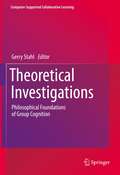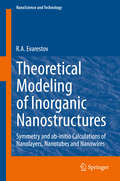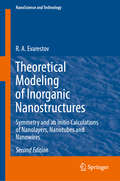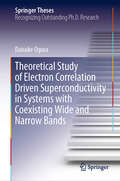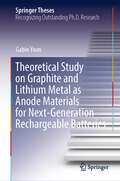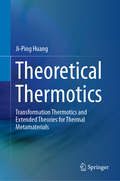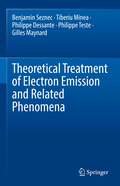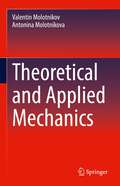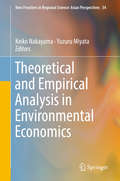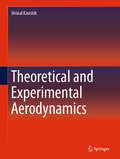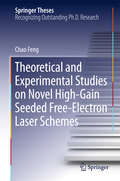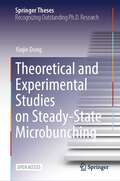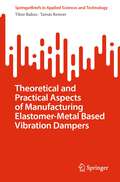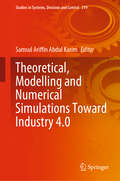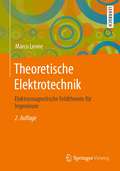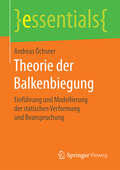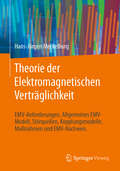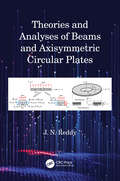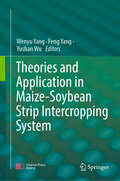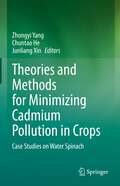- Table View
- List View
Theoretical Investigations: Philosophical Foundations of Group Cognition (Computer-Supported Collaborative Learning Series #18)
by Gerry StahlComputers have transformed how we think, discuss and learn—as individuals, in groups, within cultures and globally. However, social media are problematic, fostering flaming, culture wars and fake news. This volume presents an alternative paradigm for computer support of group thinking, collaborative learning and joint knowledge construction. This requires expanding concepts of cognition to collectivities, like collaborative groups of networked students. Theoretical Investigations explores the conditions for group cognition, supplying a philosophical foundation for new models of pedagogy and methods to analyze group interaction. Twenty-five self-contained investigations document progress in research on computer-supported collaborative learning (CSCL)—both in Stahl’s own research and during the first decade of the CSCL journal.The volume begins with two new reflections on the vision and theory that result from this research. Representing both ethnomethodological and social-constructivist research paradigms, the investigations within this volume comprise a selection of seminal and influential articles and critical commentaries that contribute to an understanding of concepts and themes central to the CSCL field. The book elaborates an innovative theory of group cognition and substantiates the pedagogical potential of CSCL. Theoretical Investigations: Philosophical Foundations of Group Cognition is essential as a graduate text for courses in educational theory, instructional design, learning and networked technologies. The investigations will also appeal to researchers and practitioners in those areas.
Theoretical Modeling of Inorganic Nanostructures
by R. A. EvarestovThis book deals with the theoretical and computational simulation of monoperiodic nanostructures for different classes of inorganic substances. These simulations are related to their synthesis and experimental studies. A theoretical formalism is developed to describe 1D nanostructures with symmetric shapes and morphologies. Three types of models are considered for this aim: (i) nanotubes (rolled from 2D nanolayers and described within the formalism of line symmetry groups); (ii) nanoribbons (obtained from 2D nanolayers by their cutting along the chosen direction of translation); (iii) nanowires (obtained from 3D lattice by its sectioning along the crystalline planes parallel to the chosen direction of translation). Quantum chemistry ab-initio methods applied for LCAO calculations on electronic and vibrational properties of 1D nanostructures are thoroughly described. Understanding of theoretical aspects presented here enlarges the possibilities for synthesis of monoperiodic nanostructures with predictable morphology and better interpretation of their properties.
Theoretical Modeling of Inorganic Nanostructures: Symmetry and ab initio Calculations of Nanolayers, Nanotubes and Nanowires (NanoScience and Technology)
by R. A. EvarestovThis book summarizes the state of the art in the theoretical modeling of inorganic nanostructures. Extending the first edition, published in 2015, it presents applications to new nanostructured materials and theoretical explanations of recently discovered optical and thermodynamic properties of known nanomaterials. It discusses the developments in theoretical modeling of nanostructures, describing fundamental approaches such as symmetry analysis and applied calculation methods. The book also examines the theoretical aspects of many thermodynamic and the optical properties of nanostructures. The new edition includes additional descriptions of the theoretical modeling of nanostructures in novel materials such as the V2O5 binary oxide, ZnS, CdS, MoSSe and SnS2.
Theoretical Study of Electron Correlation Driven Superconductivity in Systems with Coexisting Wide and Narrow Bands (Springer Theses)
by Daisuke OguraThis book deals with the study of superconductivity in systems with coexisting wide and narrow bands. It has been previously suggested that superconductivity can be enhanced in systems with coexisting wide and narrow bands when the Fermi level is near the narrow band edge. In this book, the authors study two problems concerning this mechanism in order to: (a) provide a systematic understanding of the role of strong electron correlation effects, and (b) propose a realistic candidate material which meets the ideal criteria for high-Tc superconductivity. Regarding the role of strong correlation effects, the FLEX+DMFT method is adopted. Based on systematic calculations, the pairing mechanism is found to be indeed valid even when the strong correlation effect is considered within the formalism. In the second half of the book, the authors propose a feasible candidate material by introducing the concept of the “hidden ladder” electronic structure, arising from the combination of the bilayer lattice structure and the anisotropic orbitals of the electrons. As such, the book contributes a valuable theoretical guiding principle for seeking unknown high-Tc superconductors.
Theoretical Study on Graphite and Lithium Metal as Anode Materials for Next-Generation Rechargeable Batteries (Springer Theses)
by Gabin YoonThis thesis describes in-depth theoretical efforts to understand the reaction mechanism of graphite and lithium metal as anodes for next-generation rechargeable batteries. The first part deals with Na intercalation chemistry in graphite, whose understanding is crucial for utilizing graphite as an anode for Na-ion batteries. The author demonstrates that Na ion intercalation in graphite is thermodynamically unstable because of the unfavorable Na-graphene interaction. To address this issue, the inclusion of screening moieties, such as solvents, is suggested and proven to enable reversible Na-solvent cointercalation in graphite. Furthermore, the author provides the correlation between the intercalation behavior and the properties of solvents, suggesting a general strategy to tailor the electrochemical intercalation chemistry. The second part addresses the Li dendrite growth issue, which is preventing practical application of Li metal anodes. A continuum mechanics study considering various experimental conditions reveals the origins of irregular growth of Li metal. The findings provide crucial clues for developing effective counter strategies to control the Li metal growth, which will advance the application of high-energy-density Li metal anodes.
Theoretical Thermotics: Transformation Thermotics and Extended Theories for Thermal Metamaterials
by Ji-Ping HuangThis book focuses on theoretical thermotics, the theory of transformation thermotics and its extended theories for the active control of macroscopic thermal phenomena of artificial systems, which is in sharp contrast to classical thermodynamics comprising the four thermodynamic laws for the passive description of macroscopic thermal phenomena of natural systems. The book covers the basic concepts and mathematical methods, which are necessary to understand thermal problems extensively investigated in physics, but also in other disciplines of engineering and materials. The analyses rely on models solved by analytical techniques accompanied with computer simulations and laboratory experiments. This book serves both as a reference work for senior researchers and a study text for zero beginners.
Theoretical Treatment of Electron Emission and Related Phenomena
by Benjamin Seznec Tiberiu Minea Philippe Dessante Philippe Teste Gilles MaynardThis book introduces readers to the physics governing electron emission under high voltages and temperatures, and highlights recent modeling and numerical developments for describing these phenomena. It begins with a brief introduction, presenting several applications that have driven electron emission research in the last few decades. The authors summarize the most relevant theories including the physics of thermo-field electron emission and the main characteristic parameters. Based on these theories, they subsequently describe numerical multi-physics models and discuss the main findings on the effect of space charges, emitter geometry, pulse duration, etc.Beyond the well-known photoelectric effect, the book reviews recent advanced theories on photon-metal interaction. Distinct phenomena occur when picosecond and femtosecond lasers are used to irradiate a surface. Their consequences on metal electron dynamics and heating are presented and discussed, leading to various emission regimes – in and out of equilibrium. In closing, the book reviews the effects of electron emission on high-voltage operation in vacuum, especially breakdown and conditioning, as the most common examples. The book offers a uniquely valuable resource for graduate and PhD students whose work involves electron emission, high-voltage holding, laser irradiation of surfaces, vacuum or discharge breakdown, but also for academic researchers and professionals in the field of accelerators and solid state physics with an interest in this highly topical area.
Theoretical and Applied Mechanics
by Valentin Molotnikov Antonina MolotnikovaThis textbook summarizes the course of engineering mechanics, designed for one or two semesters, at the undergraduate or graduate level for a range of academic majors. The book covers all the main components of the discipline including: Theoretical Mechanics, Theory of Mechanisms and Machines, Resistance of Materials, Machine Parts and Design Basic; and Interchangeability, Standardization, and Technical Measurements. It can also be used by students of other technical areas in to achieve competence in each of the listed disciplines. The concise presentation facilitates concentration on the most important elements of the concepts presented while also outlining the current state of mechanics, demonstrating engineering applications using various computer packages (MathCad, CosmosWorks, Inkscape, AutoCad), and updating data on engineering materials. Examples of both simple and complex engineering calculations are given at the end of each chapter along with self-assessment questions.
Theoretical and Computational Aerodynamics (Aerospace Series)
by Tapan K. SenguptaAerodynamics has seen many developments due to the growth of scientific computing, which has caused the design cycle time of aerospace vehicles to be heavily reduced. Today computational aerodynamics appears in the preliminary step of a new design, relegating costly, time-consuming wind tunnel testing to the final stages of design. Theoretical and Computational Aerodynamics is aimed to be a comprehensive textbook, covering classical aerodynamic theories and recent applications made possible by computational aerodynamics. It starts with a discussion on lift and drag from an overall dynamical approach, and after stating the governing Navier-Stokes equation, covers potential flows and panel method. Low aspect ratio and delta wings (including vortex breakdown) are also discussed in detail, and after introducing boundary layer theory, computational aerodynamics is covered for DNS and LES. Other topics covered are on flow transition to analyse NLF airfoils, bypass transition, streamwise and cross-flow instability over swept wings, viscous transonic flow over airfoils, low Reynolds number aerodynamics, high lift devices and flow control. Key features: Blends classical theories of incompressible aerodynamics to panel methods Covers lifting surface theories and low aspect ratio wing and wing-body aerodynamics Presents computational aerodynamics from first principles for incompressible and compressible flows Covers unsteady and low Reynolds number aerodynamics Includes an up-to-date account of DNS of airfoil aerodynamics including flow transition for NLF airfoils Contains chapter problems and illustrative examples Accompanied by a website hosting problems and a solution manual Theoretical and Computational Aerodynamics is an ideal textbook for undergraduate and graduate students, and is also aimed to be a useful resource book on aerodynamics for researchers and practitioners in the research labs and the industry.
Theoretical and Empirical Analysis in Environmental Economics (New Frontiers in Regional Science: Asian Perspectives #34)
by Yuzuru Miyata Keiko NakayamaThis monograph presents potential remedies for some of the current environmental issues in developed countries in a theoretical or empirical manner with the interdisciplinary approaches of economics, statistics, and engineering. The book illustrates effective economic and environmental policies for environmental challenges and factors where corrective policies to date may have failed. The importance of this essential book has is related to the transition in the major concerns of the people or governments in developed countries shifting from economic growth to the stability of life and environmental preservation as their economies have matured. The environmental issues dealt with here include forest environment tax introduced as part of local taxes, air pollution reduction policies for mobile emission sources, introduction of renewable energies and power fuel cell technology, the mechanism of city agglomeration and dispersion, and measurement of environmental sustainability. In analytical methods, some research employs theoretical approaches such as the mathematical economic model or nonlinear dynamic model. Other analyses are implemented with empirical or statistical tools such as the long-run general equilibrium model, the input–output model, and the dynamic optimization model, among others.
Theoretical and Experimental Aerodynamics
by Mrinal KaushikThis book is intended as a text for undergraduate and graduate courses in aerodynamics, typically offered to students of aerospace and mechanical engineering programs. It covers all aspects of aerodynamics. The book begins with a description of the standard atmosphere and basic concepts, then moves on to cover the equations and mathematical models used to describe and characterize flow fields, as well as their thermodynamic aspects and applications. Specific emphasis is placed on the relation between concepts and their use in aircraft design. Additional topics of interest to the reader are presented in the Appendix, which draws on the teachings provided in the text. The book is written in an easy to understand manner, with pedagogical aids such as chapter overviews, summaries, and descriptive and objective questions to help students evaluate their progress. Atmospheric and gas tables are provided to facilitate problem solving. Lastly, a detailed bibliography is included at the end of each chapter to provide students with further resources. The book can also be used as a text for professional development courses in aerodynamics.
Theoretical and Experimental Studies on Novel High-Gain Seeded Free-Electron Laser Schemes
by Chao FengThis dissertation focuses on the study of novel high-gain free-electron laser (FEL) operation schemes with external seed lasers. The technique of manipulating the phase space of the electron beam, which is widely used in novel seeded FEL schemes, is systematically studied. Several novel FEL schemes are proposed for the generation of intense coherent FEL pulses with short wavelength, sub-femtosecond pulse length or multiple carrier frequency properties, which meet the needs of FEL users. Results of experiments are described for the recently proposed FEL schemes such as echo-enabled harmonic generation and cascaded high-gain harmonic generation. New photon/electron beam diagnostic methods are also developed for these experiments and future high-gain FEL facilities.
Theoretical and Experimental Studies on Steady-State Microbunching (Springer Theses)
by Xiujie DengThis open access book is devoted to the theoretical and experimental studies of a novel accelerator light source mechanism called steady-state microbunching (SSMB) which promises high-power, high-repetition rate, narrow-band coherent radiation in an electron storage ring. The contribution of this dissertation consists of three parts: first, answers the question of how to realize SSMB from a beam dynamics perspective; second, reveals what radiation characteristics can we obtain from the formed SSMB; and third, experimentally demonstrates the working mechanism of SSMB in a real machine for the first time. The highlights of this book can be summarized as: Presents the first proof-of-principle experiment of a promising accelerator light source mechanism; Covers precision longitudinal and transverse-longitudinal coupling dynamics in a storage ring; Provides useful formulas and example parameters for high-power infrared, EUV and soft X-ray light source design.
Theoretical and Practical Aspects of Manufacturing Elastomer-Metal Based Vibration Dampers (SpringerBriefs in Applied Sciences and Technology)
by Tibor Babos Tamás RennerThis book offers a comprehensive breakdown of rubber industry procedures, serving as an invaluable resource for enhancing professional literacy. It covers measurable technological parameters, manufacturing processes, and metallurgy of the materials required for producing high-value rubber-metal machine components. These components find wide applications in the engineering industry, including buffers, vibration damping elements, pipe expansion joints, and silent blocks (vibration dampers vulcanized between steel pipes). The manufacturing of modern machine components necessitates meeting high technical standards and ensuring flawless performance throughout their lifetime. This goal is accomplished by manufacturing components to the required technical parameters with consistent quality specified during the design stage. Unfortunately, scientific descriptions of rubber-metal bonding technologies often lack the detail required for practical application. This book addresses this gap by presenting extensive research conducted by Renner Rubber Products, a key player in the rubber market in Central Europe, drawing on practical experience from the Centre for Security Studies at the Hungarian University of Agriculture and Life Sciences. The book provides a set of technological specifications for rubber-metal bonding based on experiments, measurements, calculations, and proven research results. A noteworthy aspect of the book is that it is the result of close scientific collaboration between academia and industry-leading players, resulting in a highly qualified product applicable in science, academia, and industrial production alike. It serves as a valuable tool for anyone in the engineering industry seeking to enhance their understanding of rubber industry procedures and produce high-quality rubber-metal machine components.
Theoretical, Computational, and Experimental Solutions to Thermo-Fluid Systems: Select Proceedings of ICITFES 2020 (Lecture Notes in Mechanical Engineering)
by Muthukumar Palanisamy Velraj Ramalingam Murugan SivalingamThis book presents select proceedings of the International Conference on Innovations in Thermo-Fluid Engineering and Sciences (ICITFES 2020). It covers topics in theoretical and experimental fluid dynamics, numerical methods in heat transfer and fluid mechanics, different modes of heat transfer, multiphase flow, fluid machinery, fluid power, refrigeration and air conditioning, and cryogenics. The book will be helpful to the researchers, scientists, and professionals working in the field of fluid mechanics and machinery, and thermal engineering.
Theoretical, Modelling and Numerical Simulations Toward Industry 4.0 (Studies in Systems, Decision and Control #319)
by Samsul Ariffin Abdul KarimThis book presents theoretical modeling and numerical simulations applied to drive several applications towards Industrial Revolution 4.0 (IR 4.0). The topics discussed range from theoretical parts to extensive simulations involving many efficient algorithms as well as various statistical techniques. This book is suitable for postgraduate students, researchers as well as other scientists who are working in mathematics, statistics and numerical modeling and simulation.
Theoretische Elektrotechnik: Elektromagnetische Feldtheorie für Ingenieure
by Marco LeoneAm Anfang des Buches wird die allgemeine Maxwell’sche Theorie elektromagnetischer Felder und ihre Unterteilung für die unterschiedlichen Problemstellungen ausführlich dargestellt. Auf die Verbindung zwischen Feldtheorie und der elektrischen Netzwerke wird ausführlich eingegangen. Der methodische Schwerpunkt liegt in der Aufstellung und Lösung grundlegender Randwertprobleme der Elektro- und Magnetostatik, zeitabhängiger Diffusionsfelder in elektrischen Leitern sowie Wellenfelder im Freiraum, entlang von Leitungen und in Hohlräumen. Dabei wird auf die Einheitlichkeit der übergeordneten Lösungsmethodik besonders Wert gelegt, sodass das einmal Erlernte auf andere Problemstellungen übertragen werden kann. Ausführliche Rechenbeispiele und zusätzliche Übungsaufgaben mit Lösungen dienen zur Vertiefung und Klausurvorbereitung. Die dafür benötigten mathematischen Formeln der Vektoralgebra, Koordinatensysteme und der Vektoranalysis sind in einem Anhang zum Nachschlagen zusammengestellt.
Theoretische Strömungsmechanik: Eine anwendungsorientierte Einführung mit ausführlichen Herleitungen
by Raj SpielmannDas Buch bietet einen didaktisch ausgearbeiteten Einstieg in die theoretische Strömungsmechanik und gibt gleichzeitig Einblicke in die Vielfalt ihrer Anwendungen in Natur und Technik. Der Schwerpunkt liegt auf der Aerodynamik für niedrigere Fluggeschwindigkeiten, die unvermindert von hohem praktischen Wert ist, jedoch in der Einführungsliteratur meist zu kurz kommt. Bei den Herleitungen wird darauf Wert gelegt, die entsprechenden Begriffe und Zusammenhänge zu veranschaulichen. Damit richtet sich der Text in erster Linie an Studierende der Mathematik, die eine Brücke zu ingenieurtechnischen Anwendungen suchen. Ebenso sollte er für Ingenieure nützlich sein, die sich für die Herleitung der Formeln und Hintergründe interessieren. Zur lückenlosen Verständlichkeit wurden zahlreiche Zwischenschritte beim Rechnen, die für gewöhnlich dem Leser überlassen werden, in Aufgaben verpackt. Ergänzt durch Fragen zum Konzeptverständnis werden sie im Lösungsteil nachgerechnet. Damit bleibt die Darstellung für einen breiten Interessentenkreis von Nutzen.
Theorie der Balkenbiegung: Einführung und Modellierung der statischen Verformung und Beanspruchung (essentials)
by Andreas ÖchsnerAndreas Öchsner bietet eine Einführung in die unterschiedlichen Theorien der statischen Balkenbiegung sowie deren Annahmen und Limitierungen. Er behandelt insbesondere die Theorien nach Euler-Bernoulli, Timoshenko und Levinson bei kleinen Verformungen und Dehnungen. Dieses Wissen bildet die Grundlage für die Anwendung moderner Berechnungsmethoden, zum Beispiel der Methode der finiten Elemente (FEM). Das Buch bietet eine kompakte und schnelle „Anleitung“ zur Anwendung der unterschiedlichen Balkentheorien. Die Annahmen und Limitierungen werden hier vergleichend in einem Werk dargestellt. Die grundlegenden Beziehungen, die zur beschreibenden Differenzialgleichung führen, sind ausführlich dargestellt und erläutert.
Theorie der Elektromagnetischen Verträglichkeit: EMV-Anforderungen, Allgemeines EMV-Modell, Störquellen, Kopplungsmodelle, Maßnahmen und EMV-Nachweis.
by Hans-Jürgen MeckelburgDas Buch vermittelt ein grundlegendes Verständnis für die Prinzipien und Verfahren der Elektromagnetischen Verträglichkeit. Es gibt einen umfassenden Überblick über alles, was man über EMV wissen sollte. Aufbauend auf dem „Allgemeinen Verträglichkeits-Modell“, das zum ersten Mal in einem Lehrbuch entwickelt wird, ergibt sich der logische Aufbau des Buches. Die Abstrahlung von Störungen von Stromkreisen, die Ausbreitung von Störungen als geführte Wellen zwischen Leitern und der Erde oder Masse sowie die Schirmwirkung abgeschirmter Leitungen wird zum ersten Mal in einem Lehrbuch feldtheoretisch abgeleitet und bewiesen. EMV-Anforderungen sind in fast allen Ländern der Erde gesetzlich vorgeschrieben. Da in Normen keine Grundlagen erläutert werden, sind viele Anforderungen nicht unmittelbar nachvollziehbar. Das Buch kann dabei helfen, die Anforderungen richtig einzuordnen. Die hierfür erforderlichen mathematischen Methoden, wie zeitharmonische Vorgänge, Signalanalyse, Vektoranalysis und Feldtheorie werden zugeschnitten für die Elektromagnetische Verträglichkeit im Anhang dargestellt.
Theories and Analyses of Beams and Axisymmetric Circular Plates
by J N ReddyThis comprehensive textbook compiles cutting-edge research on beams and circular plates, covering theories, analytical solutions, and numerical solutions of interest to students, researchers, and engineers working in industry. Detailing both classical and shear deformation theories, the book provides a complete study of beam and plate theories, their analytical (exact) solutions, variational solutions, and numerical solutions using the finite element method. Beams and plates are some of the most common structural elements used in many engineering structures. The book details both classical and advanced (i.e., shear deformation) theories, scaling in complexity to aid the reader in self-study, or to correspond with a taught course. It covers topics including equations of elasticity, equations of motion of the classical and first-order shear deformation theories, and analytical solutions for bending, buckling, and natural vibration. Additionally, it details static as well as transient response based on exact, the Navier, and variational solution approaches for beams and axisymmetric circular plates, and has dedicated chapters on linear and nonlinear finite element analysis of beams and circular plates. Theories and Analyses of Beams and Axisymmetric Circular Plates will be of interest to aerospace, civil, materials, and mechanical engineers, alongside students and researchers in solid and structural mechanics.
Theories and Application in Maize-Soybean Strip Intercropping System
by Feng Yang Wenyu Yang Yushan WuThis book provides comprehensive coverage of the advances in theoretical and technical research on the maize-soybean strip intercropping system. Intercropping plays an important role in producing more yields for those countries with a large population and limited arable land, especially for cereal and legume intercropping systems. Maize and soybean are best partners under cereal and legume intercropping conditions. The chapters feature the latest developments in intercropping research and cover such topics as the mechanism of resource-efficient utilization, determination of the optimum planting geometry for maize–soybean strip intercropping system according to the yield advantage, and the application of agricultural machinery for intercropping mechanization. The volume also features the response of intercrops to a light environment based on the methods of physiological and molecular biology, laying the groundwork for future advances in variety breeding and crop field configuration. This book will serve as an invaluable reference for agricultural production, teaching, and research of the cropping system in the future.
Theories and Methods for Minimizing Cadmium Pollution in Crops: Case Studies on Water Spinach
by Zhongyi Yang Chuntao He Junliang XinThe cadmium (Cd) contamination has raised increasingly global concern on food safety. The book was composed to bring comprehensive and valuable thoughts about the food safety management against heavy metal contamination. In this book, current status of cadmium contamination in agricultural soils and crops is systematically summarized. In order to reduce the risk of Cd pollution in crops, Cd pollution-safe cultivar (Cd-PSC) strategy, i.e. identifying, breeding and applying the cultivars with particularly low Cd accumulation capacity in edible parts even when grown in Cd contaminated soil, is proposed as a most effective, low-cost and environmental-friendly method for minimizing Cd pollution in crops. To describe the framework of the Cd-PSC strategy, a series research results on water spinach (Ipomoea aquatica Forsk) are summarized as a typical case. The latest findings about the Cd-PSCs of water spinach, including cultivar variation in shoot Cd accumulation, identification and verification of low- and high-Cd accumulating cultivars, stability of Cd accumulation capacity at the cultivar level, biochemical and molecular mechanisms of the cultivar-dependent Cd uptake, transfer and accumulation, breeding methods for improving Cd-PSCs, and so on, have been covered. This book will provide valuable theoretical and practical understandings for controlling Cd pollution in crops grown on agricultural soils with known or unknown risk of Cd contamination.
Theories and Models of Urbanization: Geography, Economics and Computing Sciences (Lecture Notes in Morphogenesis)
by Denise PumainThis book provides a thorough discussion about fundamental questions regarding urban theories and modeling. It is a curated collection of contributions to a workshop held in Paris on October 12th and 13th 2017 at the Institute of Complex Systems by the team of ERC GeoDiverCity. There are several chapters conveying the answers given by single authors to problems of conceptualization and modeling and others in which scholars reply to their conception and question them. Even, the chapters transcribing keynote presentations were rewritten according to contributions from the respective discussions. The result is a complete “state of the art” of what is our knowledge about urban processes and their possible formalization.
Theories and Practice in Interaction Design
by Craig E. RasmussenAd hoc and interdisciplinary, the field of interaction design claims no unified theory. Yet guidelines are needed. In essays by 26 major thinkers and designers, this book presents the rich mosaic of ideas which nourish the lively art of interaction design. The editors introduction is a critical survey of interaction design with a debt and contribut
